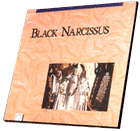Director:
Michael Powell and Emeric Pressburger
CLV: $49.95 -
1 disc, catalog # CC1138L
Black Narcissus was the sixth production from that remarkable
pair of artists Michael Powell and Emeric Pressburger, collectively
known as The Archers, who dominated the creative side of the British
film industry from 1943 through 1956.
Based on Rumer Godden's 1939 novel, Black Narcissus tells
the story of five nuns of the Anglo-Catholic faith who are dedicated
to work and welcome the assignment to open a school and hospital in
remote Hindustan. Under the newly appointed Sister Superior Clodagh,
the group journeys to an old castle formerly used by an Oriental
potentate to house his harem. The palace stands atop a Himalayan
mountain 9,000 feet high and is constantly swept by the unceasing
winds. In the high, rarefied, vast and lonely spaces, the nuns strive,
by hard labor, to erase their memories of the world. But the altitude
and exotic atmosphere begin to take their psychological toll.
Into their cloistered lives creep uncertainties about the
infallibility of their work, their order, their mission, sometimes
even about their faith and its relative merits as compared with the
barbaric faith of the people around them: the silent pagan "holy man"
forever seated on the mountain, eternally gazing at the peaks; the
toothless, eccentric, screeching servant Ayah; the exotic, sensuous
young native girl Kanchi; and the young General with his regal robes
and his Black Narcissus perfume are all distracting influences;
but the most disturbing is the frequent presence of Mr. Dean, a
drunken, cynical ne'er-do-well British agent who insists that the nuns
won't last till the rainy season starts. His overt masculine sexuality
is the catalyst that eventually causes the nuns to start coming apart.
Sister Superior Clodagh is defeated by her youth, her uncontrollable
feeling of superiority and recurring memories of her girlhood in
Ireland when she was in love. Sister Philippa finds herself so lost in
memories of the past and a desire for beauty that she plants flowers
instead of the vegetables they need. Sister Briony is overcome by the
superstitions of the natives who are willing to accept her medicine as
a kind of magic. Sister Honey mistakenly gives a desperately ill baby
castor oil, causing its death, which alienates the natives. Sister
Ruth, a borderline neurotic, goes berserk, abandons her vows, dresses
in provocative clothing and tries to seduce Dean.
To attempt to film such a subtle, delicate story called for
imagination, restraint and artistry in writing, directing and art
direction. Emeric Pressburger's screenplay was civilized, worldly,
daring and obliquely discreet in conveying the gradual disintegration
of the nuns' psyches. But it was Michael Powell's direction that
managed to achieve a perfect fusion of all the elements of cinematic
art -- art direction, cinematography, performances and music are all
integrated so gracefully and with such exquisite taste and sense of
style that the resulting film was hailed as having "an almost
breathtaking sense of beauty." Black Narcissus abounds in
unforgettable images: a ghostly Indian palace perched on the edge of a
precipice; the dreamlike strangeness of the eerie moonlight in the
palace rooms; the flowing off-white robes of the nuns contrasting with
the wild unearthly beauty of their surroundings; the misty dawn and
the flaring sunsets stylized almost to the point of
unreality. Black Narcissus is one of the high points of
Technicolor photography; Jack Cardiff's work on the film as well as
Alfred Junge's production design won Academy Awards, and the film is
used even today as a textbook example of how color and design should
be used to suggest psychological moods and to create dramatic
atmosphere.
The rich exotic tapestry of Black Narcissus is splendidly
conveyed in this Criterion laserdisc edition. Michael Powell and
Martin Scorsese comment individually on the film on the disc's second
audio track -- Powell on the production techniques used to film this
spectacular story entirely in a London studio, and in an English
garden, while Scorsese points out the innovative technique and how the
interaction of performance, music and photography combine to create in
Black Narcissus one of the most perfectly realized of all the
Powell-Pressburger films and indeed one of the most superb films ever
made by anyone anywhere.
-- RONALD HAVER
Credits
Written, Produced, and Directed by:
Michael Powell and Emeric Pressburger
Adapted from the novel by: Rumer Godden
Photographed in Technicolor by: Jack Cardiff F.R.P.S.
Music Composed and Conducted by: Brian Easdale, London Symphony Orchestra
Editor: Reginald Mills
Sound: Stanley Lambourne
Transfer
This edition of Black Narcissus was transferred from a
Technicolor 35mm master print.
|


